new posts in all blogs
Viewing: Blog Posts Tagged with: Steve Sheinkin, Most Recent at Top [Help]
Results 1 - 25 of 32
How to use this Page
You are viewing the most recent posts tagged with the words: Steve Sheinkin in the JacketFlap blog reader. What is a tag? Think of a tag as a keyword or category label. Tags can both help you find posts on JacketFlap.com as well as provide an easy way for you to "remember" and classify posts for later recall. Try adding a tag yourself by clicking "Add a tag" below a post's header. Scroll down through the list of Recent Posts in the left column and click on a post title that sounds interesting. You can view all posts from a specific blog by clicking the Blog name in the right column, or you can click a 'More Posts from this Blog' link in any individual post.
Recently I hosted a Literary Salon where an attendee asked at the end whether or not it was true that Kate DiCamillo deleted every draft she wrote, right after finishing it, so that she could rewrite it again. As it turns out, this isn’t exactly the case, but it did lead a lot of us to wonder how Kate writes in general. A secret signal must have been sent through the ether because not three days later I got word from author Steve Sheinkin that he had a new Walking and Talking feature to present. And its subject? Kate DiCamillo! Enjoy, folks. All shall be revealed:
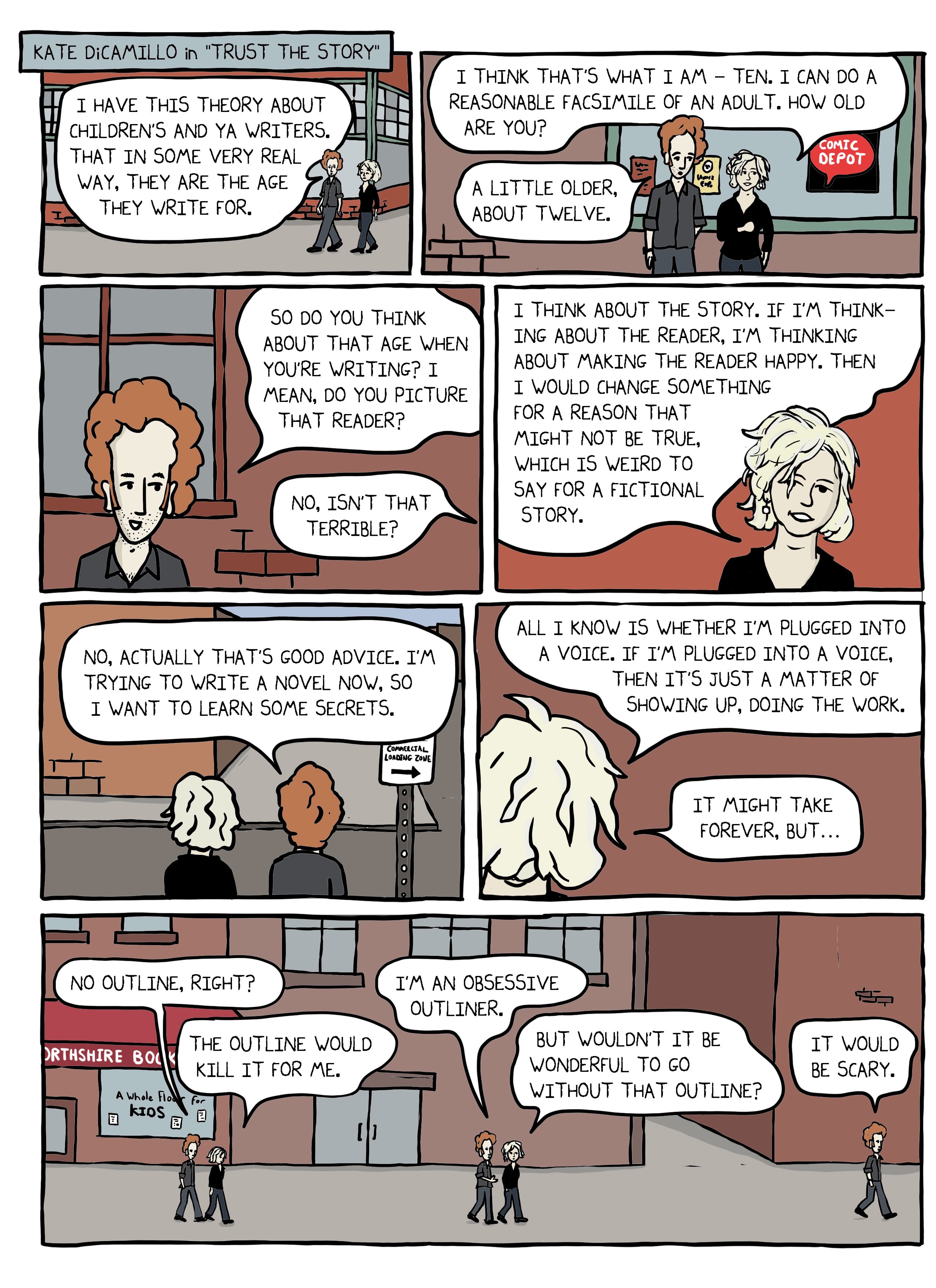

Thanks yet once more to Steve for allowing me to show off his fantastic comics. For previous entries in the “Walking and Talking” series, please be sure to check out the following:

There were many fine and fantastic works of nonfiction for older children and teens in 2015. One such book won the YALSA Award for Excellence in Nonfiction Award while another won an Honor. Now those two authors chat about the process of creating narrative nonfiction. We’ve featured a fair number of Walking and Talking chats on this site, but I think this one is of particular note. Ladies and gentlemen, I give you Steve Sheinkin in conversation with M.T. Anderson:

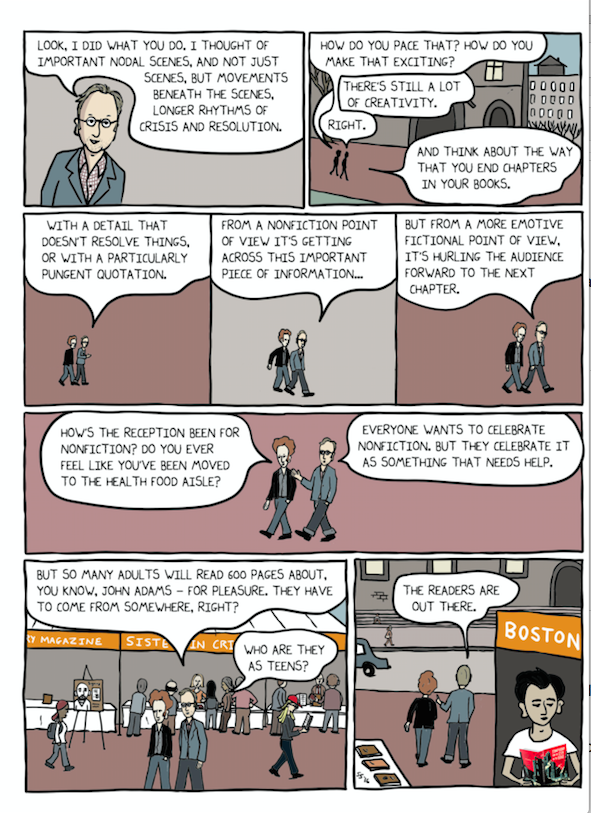
For those of you curious about Mr. Anderson’s book you can see my interview with him here.
Thanks to Steve for allowing me to showcase his work. For previous entries in the “Walking and Talking” series, please be sure to check out the following:

Such a treat! So I’m finally reading Steve Sheikin’s latest nonfiction work, Most Dangerous, and then out of the blue he sends me the latest in his “Walking and Talking” series. Dav Pilkey, Mr. Captain Underpants himself, is today’s subject. Fun Pilkey Fact You Never Knew: He has exquisite taste in cakes. True fact!

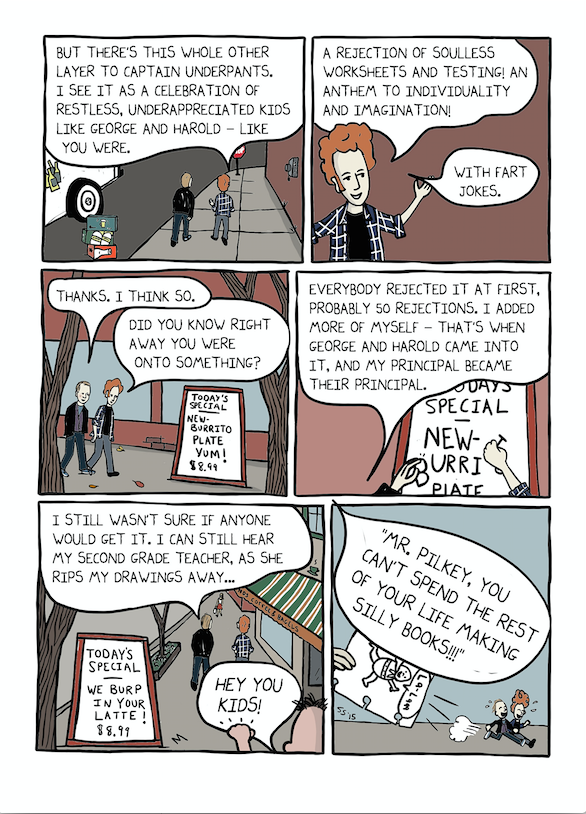
Thanks once again to Steve for allowing me to showcase his work. For previous entries in the “Walking and Talking” series, please be sure to check out the following:


By: Maryann Yin,
on 10/14/2015
Blog:
Galley Cat (Mediabistro)
(
Login to Add to MyJacketFlap)
JacketFlap tags:
Lauren Groff,
Steve Sheinkin,
Sy Montgomery,
Terrance Hayes,
Tracy K. Smith,
Adam Johnson,
Ross Gay,
Noelle Stevenson,
Ta-Nehisi Coates,
Hanya Yanagihara,
Awards,
Sally Mann,
Ali Benjamin,
Ada Limón,
Angela Flournoy,
Carla Power,
Karen E. Bender,
Patrick Phillips,
Robin Coste Lewis,
Authors,
Laura Ruby,
Neal Shusterman,
Add a tag
Steve Sheinkin returns once more to write up and illustrate his “Walking and Talking” series. As with other posts in the series, Steve will have a conversation with an author or illustrator and then pluck out and bring to life the parts that really define something about the process. Part of the reason I love these is that Steve’s such a marvelous editor. He knows how to get to the heart of a conversation. And this week’s subject is near and dear to me. Behold all that is Tim Federle!
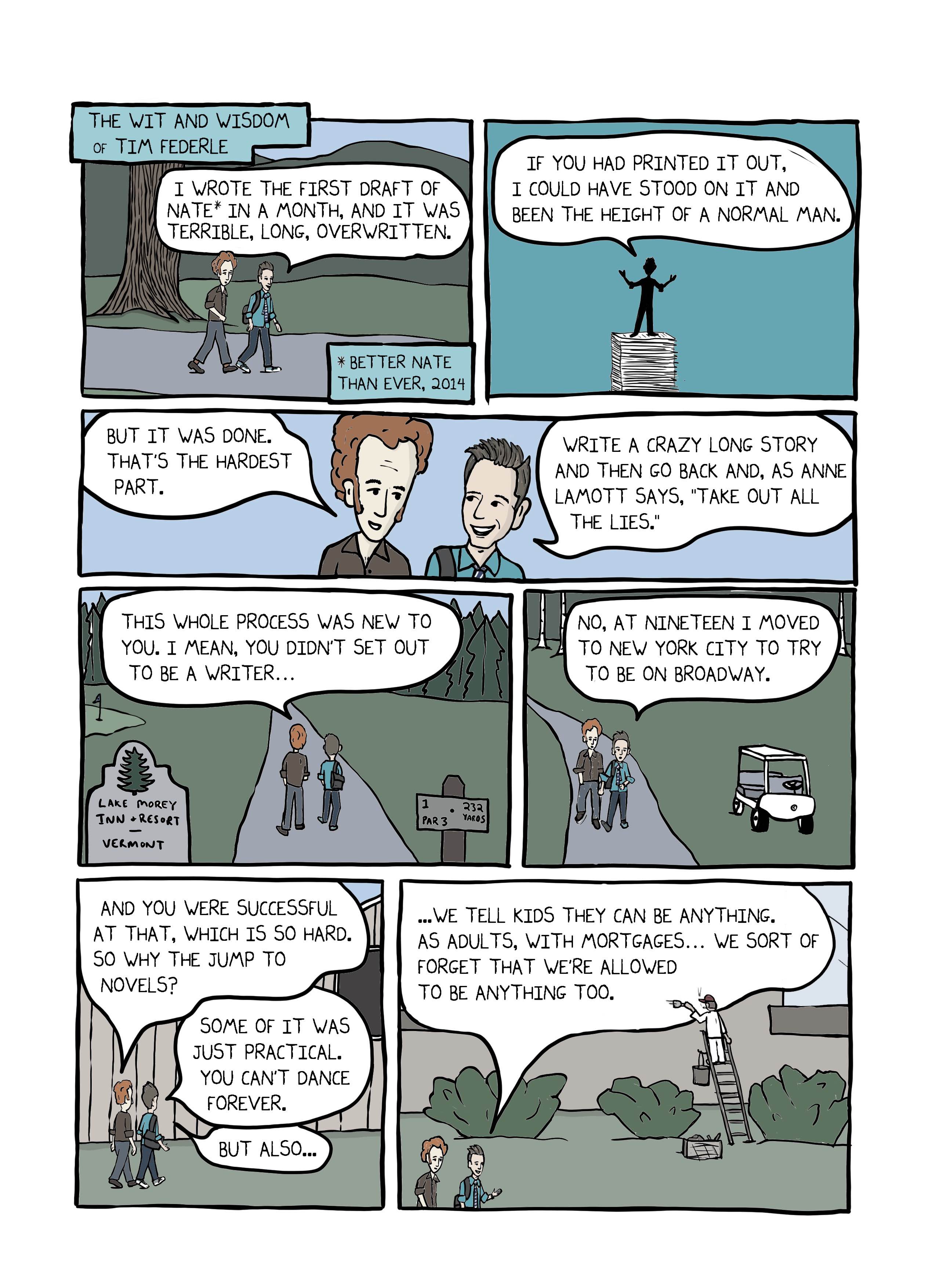
 Thanks to Steve for allowing me to showcase his work. For previous entries in the “Walking and Talking” series, please be sure to check out the following:
Thanks to Steve for allowing me to showcase his work. For previous entries in the “Walking and Talking” series, please be sure to check out the following:


By: Maryann Yin,
on 9/14/2015
Blog:
Galley Cat (Mediabistro)
(
Login to Add to MyJacketFlap)
JacketFlap tags:
Laura Ruby,
Neal Shusterman,
Gary Paulsen,
Laura McNeal,
Steve Sheinkin,
Kekla Magoon,
Eliot Schrefer,
G. Neri,
Teri Lesesne,
Rae Carson,
Noelle Stevenson,
Becky Albertalli,
Ilyasah Shabazz,
Ali Benjamin,
John Joseph Adams,
Awards,
Authors,
M. T. Anderson,
Add a tag
I’m happy to say that Steve Sheinkin’s “Walking and Talking” series is back in full swing. For those of you unaware of the Sibert winner’s predilection for drawing his conversations with his fellow literary luminaries, this is a bit of a treat. And for me, to see David Levithan fully drawn . . . well that’s just the icing on the cake, isn’t it? Here is the latest.


Once again I cannot help but thank Steve for creating this series and allowing me to post it on this site.
Previous editions of this series include:


By:
Roger Sutton,
on 8/25/2015
Blog:
Read Roger - The Horn Book editor's rants and raves
(
Login to Add to MyJacketFlap)
JacketFlap tags:
Reviews,
Nonfiction,
middle school,
Recommended Books,
Horn Book Magazine,
narrative nonfiction,
Steve Sheinkin,
Reviews of the Week,
hbmsept15,
hbmseptrevs,
Add a tag

 Most Dangerous: Daniel Ellsberg and the Secret
History of the Vietnam War
Most Dangerous: Daniel Ellsberg and the Secret
History of the Vietnam War
by Steve Sheinkin
Middle School, High School Roaring Brook 361 pp.
9/15 978-1-59643-952-8 $19.99 g
Without a wasted word or scene, and with the timing and prowess of a writer of thrillers, Sheinkin takes on a spectacularly complex story—and makes it comprehensible to teen readers: how Daniel Ellsberg evolved from a committed “cold warrior” to an antiwar activist, and why and how he leaked the Pentagon Papers—“seven thousand pages of documentary evidence of lying, by four presidents and their administrations over twenty-three years”—which led to the Watergate Scandal, the fall of the Nixon administration, and, finally, the end of the Vietnam War. From the very beginning of his account, Sheinkin demonstrates the human drama unfolding behind the scenes; the secrecy surrounding White House and Pentagon decisions; the disconnect between the public and private statements of our nation’s leaders. Throughout, readers will find themselves confronted by large, timely questions, all of which emerge organically from the book’s events: Can we trust our government? How do we know? How much secrecy is too much? The enormous amount of incorporated primary-source documentation (from interviews with Daniel Ellsberg himself to White House recordings) means not only that readers know much more than ordinary U.S. citizens did at the time but that every conversation and re-enacted scene feels immediate and compelling. Sheinkin (Bomb, rev. 11/12; The Port Chicago 50, rev. 3/14) has an unparalleled gift for synthesizing story and bringing American history to life; here, he’s outdone even himself. Meticulous scholarship includes a full thirty-
six pages of bibliography and source notes; judiciously placed archival photographs add to the sense of time and place.
From the September/October 2015 issue of The Horn Book Magazine.

The post Review of Most Dangerous: Daniel Ellsberg and the Secret History of the Vietnam War appeared first on The Horn Book.

By:
Roger Sutton,
on 8/25/2015
Blog:
Read Roger - The Horn Book editor's rants and raves
(
Login to Add to MyJacketFlap)
JacketFlap tags:
Reviews,
young adult,
Nonfiction,
middle school,
Recommended Books,
Horn Book Magazine,
narrative nonfiction,
Steve Sheinkin,
HBMNov12,
hbmnov12revs,
Add a tag

 Bomb: The Race to Build — and Steal — the World’s Most Dangerous Weapon by Steve Sheinkin (Flash Point/Roaring Brook)
Bomb: The Race to Build — and Steal — the World’s Most Dangerous Weapon by Steve Sheinkin (Flash Point/Roaring Brook)
While comprehensive in his synthesis of the political, historical, and scientific aspects of the creation of the first nuclear weapon, Sheinkin focuses his account with an extremely alluring angle: the spies. The book opens in 1950 with the confession of Harry Gold — but to what? And thus we flash back to Robert Oppenheimer in the dark 1930s, as he and readers are handed another question by the author: “But how was a theoretical physicist supposed to save the world?” Oppenheimer’s realization that an atomic bomb could be created to use against Nazi Germany is coupled with the knowledge that the Germans must be working from the same premise, and the Soviets are close behind. We periodically return to Gold’s ever-deepening betrayals as well as other acts of espionage, most excitingly the two stealth attacks on occupied Norway’s Vemork power plant, where the Germans were manufacturing heavy water to use in their own nuclear program. As he did in the Boston Globe–Horn Book Award winner The Notorious Benedict Arnold (rev. 1/11), Sheinkin here maintains the pace of a thriller without betraying history (source notes and an annotated bibliography are exemplary) or skipping over the science; photo galleries introducing each section help readers organize the events and players. Writing with journalistic immediacy, the author eschews editorializing up through the chilling last lines: “It’s a story with no end in sight. And, like it or not, you’re in it.” Index.
From the November/December 2012 issue of The Horn Book Magazine.

The post Review of Bomb: The Race to Build—and Steal—the World’s Most Dangerous Weapon appeared first on The Horn Book.
 The Port Chicago 50:
The Port Chicago 50:
Disaster, Mutiny, and the
Fight for Civil Rights
by Steve Sheinkin
Middle School Roaring Brook 190 pp.
1/14 978-1-59643-796-8 $19.99 g
e-book ed. 978-1-59643-983-2 $9.99
Sheinkin follows Bomb (rev. 11/12) with an account of another aspect of the Second World War, stemming from an incident that seems small in scope but whose ramifications would go on to profoundly change the armed forces and the freedom of African Americans to serve their country. The Port Chicago 50 was a group of navy recruits at Port Chicago in California doing one of the few service jobs available to black sailors at the beginning of the war: loading bombs and ammunition onto battleships. “All the officers standing on the pier and giving orders were white. All the sailors handling explosives were black.” When, as seems inevitable given the shoddy safety practices, there was an explosion that left more than three hundred dead, fifty men refused to go back to work, occasioning a trial for mutiny. Sheinkin focuses the events through the experience of Joe Small, who led the protest against the dangerous and unequal working conditions, but the narrative loses momentum as it tries to move between Small’s experience and its larger causes and effects. Still, this is an unusual entry point for the study of World War II and the nascent civil rights movement. Photographs are helpful, and documentation is thorough. Picture credits and index not seen.
From the March/April 2014 issue of The Horn Book Magazine.

The post Review of The Port Chicago 50: Disaster, Mutiny, and the
Fight for Civil Rights appeared first on The Horn Book.
 Steve Sheinkin’s young adult history books — including Bomb: The Race to Build — and Steal — the World’s Most Dangerous Weapon (a Newbery Honor Book, a National Book Award finalist, and the winner of both the Sibert Award and the YALSA Award for Excellence in Nonfiction for Young Adults) and The Port Chicago 50: Disaster, Mutiny, and the Fight for Civil Rights (a 2014 Boston Globe–Horn Book Award winner and also a National Book Award finalist) — are acclaimed for a reason. They are meticulously researched nonfiction books written with the pace, drama, and suspense of fictional thrillers. His latest, Most Dangerous: Daniel Ellsberg and the Secret History of the Vietnam War (Roaring Brook, 11–14 years), is no exception, as Sheinkin spellbindingly unfolds the entwined stories of the Vietnam War, the Watergate scandal, and Daniel Ellsberg and the Pentagon Papers — “seven thousand pages of documentary evidence of lying, by four presidents and their administrations over twenty-three years.”
Steve Sheinkin’s young adult history books — including Bomb: The Race to Build — and Steal — the World’s Most Dangerous Weapon (a Newbery Honor Book, a National Book Award finalist, and the winner of both the Sibert Award and the YALSA Award for Excellence in Nonfiction for Young Adults) and The Port Chicago 50: Disaster, Mutiny, and the Fight for Civil Rights (a 2014 Boston Globe–Horn Book Award winner and also a National Book Award finalist) — are acclaimed for a reason. They are meticulously researched nonfiction books written with the pace, drama, and suspense of fictional thrillers. His latest, Most Dangerous: Daniel Ellsberg and the Secret History of the Vietnam War (Roaring Brook, 11–14 years), is no exception, as Sheinkin spellbindingly unfolds the entwined stories of the Vietnam War, the Watergate scandal, and Daniel Ellsberg and the Pentagon Papers — “seven thousand pages of documentary evidence of lying, by four presidents and their administrations over twenty-three years.”
1. What originally drew you to Daniel Ellsberg’s particular story, within the larger narrative of the Vietnam War and the Watergate scandal?
SS: The very first thing that grabbed me was that a team of secret operatives, under direct supervision of the Nixon White House, actually broke into Ellsberg’s doctor’s office in search of information they could use to destroy him. I didn’t know the story well at that point, and wondered: what could this guy have possibly done to provoke such an incredible — and incredibly illegal — response from the president and his top advisors? Also, Ellsberg is one of those people who is considered a hero by some and a traitor by others, and that has always fascinated me.
2. President Johnson emerges as a particularly tragic figure, almost Shakespearean in his ego, in the cruel subversion of his ambitions (the War on Poverty, etc.), and in his inability to escape the quagmire that was the Vietnam War. I ended up feeling (conflictedly) sorry for him. Did you?
SS: Yes, very much so. You can really feel his agony as he makes these decisions, and the most unsettling part of all is that he seems to know all along that he’s heading for disaster. There’s a great line in his memoir about the presidency being too big for any one person to handle — there’s just no way to control events the way Americans seem to expect their leader to be able to do. But while I sympathize with him, I always end up getting angry at him, too, because I think, ultimately, his fear of political consequences was the main reason he escalated the war.
3. This story is a study in contrasts. On the one hand it’s loaded with farce. All the wigs and disguises; the botched burglaries (those conscientious employees re-locking doors!). But of course it’s a serious and important story of a defining era in our nation’s history. How did you hit upon the right tone?
SS: This story has a lot of you-can’t-make-this-up situations and characters, which makes for great material to work with in nonfiction. And I think the darkly comedic moments of bungling and farce are really essential to the overall story. It would probably just be too depressing without that stuff. It’s a matter of taste, but to me the best comedy is usually found in very serious stories — Breaking Bad did that brilliantly, to give one example. So I tried to keep the tone even, and hopefully the reader is pleasantly surprised by those comic moments.
 4. You make the point that Ellsberg’s legacy is as a First Amendment hero, while Edward Snowden, for example, has been lambasted by President Obama and Secretary Kerry. How do you think today’s political climate compares to that of the 1960s and 1970s?
4. You make the point that Ellsberg’s legacy is as a First Amendment hero, while Edward Snowden, for example, has been lambasted by President Obama and Secretary Kerry. How do you think today’s political climate compares to that of the 1960s and 1970s?
SS: Maybe the most amazing photo I came across in my research was in a 1971 newspaper article showing Daniel Ellsberg shaking hands with a young anti-war veteran named John Kerry! And now, as you say, Kerry calls Snowden a traitor. In Kerry’s case, I think the main change is that he was an outsider then and he’s an insider now. Overall, while our country’s political discourse does seem to have gotten stupider, I’m not sure the political climate has changed that much. When the Pentagon Papers story first broke, the response was mainly along partisan lines — Ellsberg’s leak was praised by one side and blasted by the other, exactly like Snowden’s. I think it’s mainly time and distance that have tipped the scales in Ellsberg’s favor, in terms of public opinion. I suspect the same will eventually happen with Snowden, but we’ll see.
5. What do you hope readers will come away with after reading this book?
SS: I always start with the same goal: to tell a good story. So I hope teen readers are engaged with the drama and action and moral dilemmas in this one. Beyond that, I hope they come away thinking about how alive and current this story is, how much we’re still wrestling with the same kinds of questions. And of course the best result of all is for a reader to finish the book and be unsatisfied — that is, inspired to find out more.
From the August 2015 issue of What Makes a Good…?

The post Five questions for Steve Sheinkin appeared first on The Horn Book.
Allo, folks!
Hosting Steve Sheinkin on Fuse #8 TV this month does have a bit of the old bringing coals to Newcastle feel to it. After all, Steve’s been generous in sharing his Walking and Talking comic series with us on this site regularly. So regularly, in fact, that it would be easy to forget that he’s one of our premiere YA nonfiction authors working today. Now his most ambitious book to date is coming out. Called MOST DANGEROUS: DANIEL ELLSBERG AND THE SECRET HISTORY OF THE VIETNAM WAR, it allowed me to commiserate with Steve over everything from our childhood schools’ failure to teach anything about the Vietnam War to the state of YA nonfiction today. Oh! And I also continue my “Reading (Too Much Into) Picture Books” series with a Dallas-like interpretation of Kathi Appelt’s BUBBA AND BEAU MEET THE RELATIVES. There is also a baby cameo. Yes indeed, I will hock my baby to get you to watch my video. I’m just that cunning.
In case you’re interested, all the other Fuse #8 TV episodes are archived here.
Once more, thanks to Macmillan for being my sponsor and helping to put this together.

That’s right.
Andrew Smith.
And it’s fantastic. The latest in Steve Sheinkin’s series “Walking and Talking”.
Enjoy it.
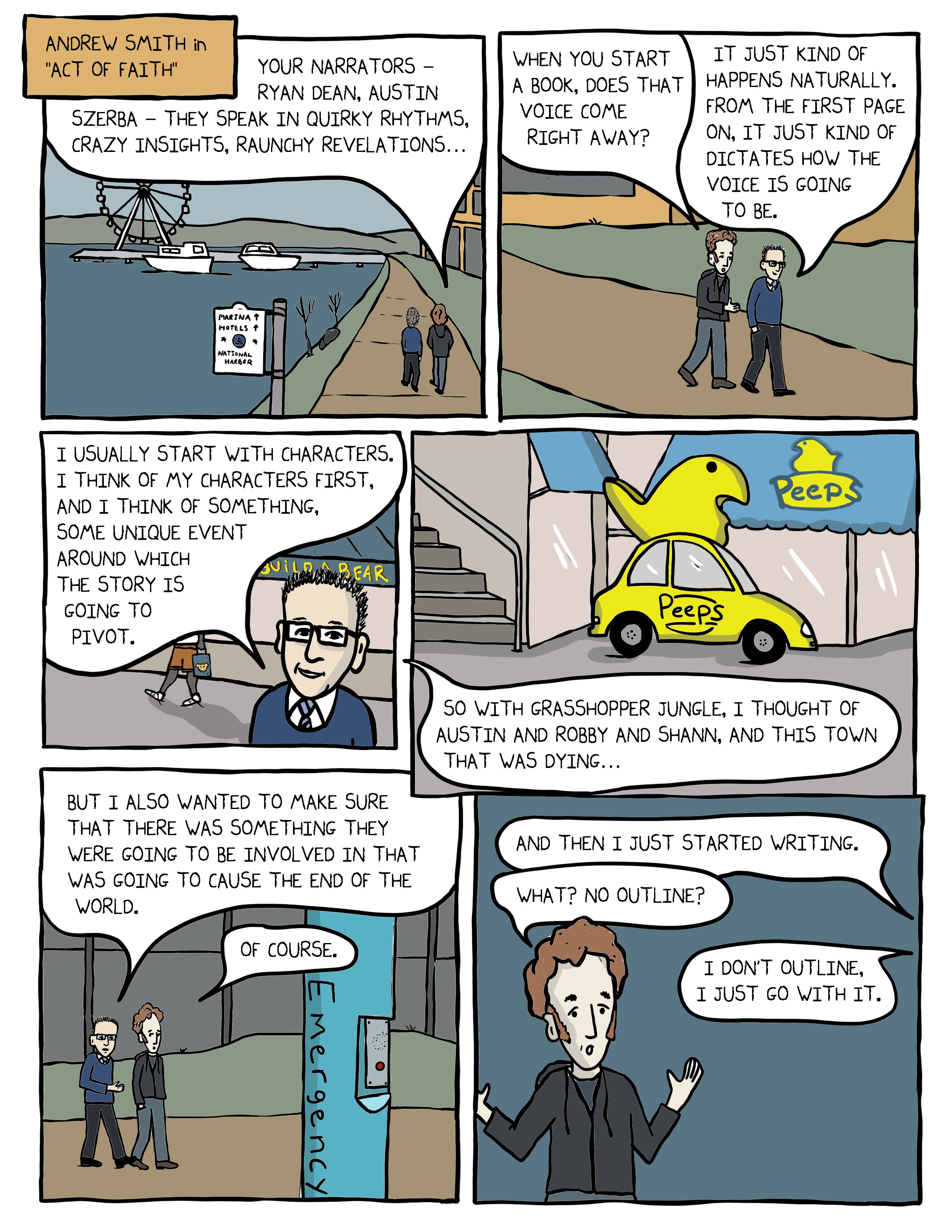

Big time thanks to Steve for putting these together and for this one in particular.
Previous editions of this series include:

The Port Chicago 50: Disaster, Mutiny, and the Fight for Civil Rights by Steve Sheinkin. Roaring Brook Press. 2014. Review copy from publisher.
The Port Chicago 50 tells a story that I was not familiar with -- actually, many stories I was not familiar with. The Port Chicago 50 are fifty African American sailors accused of mutiny in the aftermath of the Port Chicago disaster. I don't want to go into the details of the disaster or the mutiny accusations or the aftermath -- read the book!The story of these fifty men is not just about allegations of mutiny and these fifty individuals; it is also bout the segregation of the Navy and other armed forces before and during World War II and the efforts to end it. It's about just what it meant, to have segregated troops, and institutionalized racism both within and without the armed forces. Segregation and racism, and the actions at Port Chicago and by the sailors, cannot be viewed in isolation of each other.Amazon Affiliate. If you click from here to Amazon and buy something, I receive a percentage of the purchase price.
© Elizabeth Burns of
A Chair, A Fireplace & A Tea Cozy

By: Samantha McGinnis,
on 2/19/2015
Blog:
First Book
(
Login to Add to MyJacketFlap)
JacketFlap tags:
First Book Favorites,
Doug Swieteck,
The Port Chicago 50,
Baseball,
Japan,
Book lists,
Books & Reading,
Michelle Markel,
Apollo 11,
Gary D. Schmidt,
Melissa Sweet,
Aaron Meshon,
Steve Sheinkin,
Brian Floca,
Add a tag
This month on Five First Book Favorites you’ll find books that help kids understand civil rights and fair wages, explore different cultures… or even explore the moon!
For PreK – 1st (Ages 2-6)
 Take Me Out To The Yakyu By Aaron Meshon
Take Me Out To The Yakyu By Aaron Meshon
The narrator of this delightful book is a boy who loves baseball – in two different countries! He goes to games in the U.S. with his American grandfather (pop pop) and games in Japan with his Japanese grandfather (ji ji). Bold, colorful illustrations show, side-by-side, the trip to each stadium. It’s a wonderful invitation for kids to compare and contrast two different experiences and also reflect on the countries and cultures of their own families.
For Grades 1-3 (Ages 5-8)
Brave Girl: Clara and the Shirtwaist Makers’ 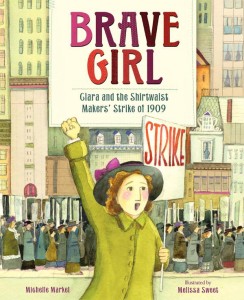 Strike of 1909 written by Michelle Markel and illustrated by Melissa Sweet
Strike of 1909 written by Michelle Markel and illustrated by Melissa Sweet
Clara Lemlich immigrated to New York with nothing aside from her family, clothes, and a few words of English. When her parents were unable to find work, she took a job as a garment factory worker – earning a few dollars a month for countless hours bent over a sewing machine. With a blend of vivid watercolors and stitched fabrics, this book tells the story of how Clara led her coworkers on strike to protest their horrendous working conditions. Bosses of the factories paid for Clara to be beaten and arrested repeatedly, but nothing could stop this gritty, five-foot tall woman from securing a better life for millions.
For Grades 2-5 (Ages 6-10)
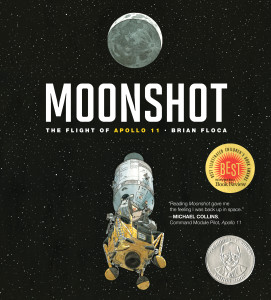 Moonshot: The Flight of Apollo 11 by Brian Floca
Moonshot: The Flight of Apollo 11 by Brian Floca
The moment Apollo 11’s Eagle touched down on the Moon, it became a defining moment for a nation that had lived up to a President’s lofty goal. With stunning illustrations, this poetic story allows you to join Armstrong, Collins, and Aldrin as they prepare for liftoff, follows them at every stage of the mission, and doesn’t let go until they are safely back home. Brian Floca has created a work of art worthy of inspiring young readers to dream beyond what is easy, and strive for what is hard.
For Grades 5+ (Ages 10 and up)
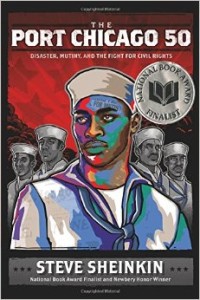
The Port Chicago 50: Disaster, Mutiny, and the Fight for Civil Rights by Steve Sheinkin
Loading 500-pound bombs into a Navy warship is, to say the least, a dangerous job. On July 17th, 1944, the fears of the untrained men who held this job became reality when an explosion claimed the lives of 320 men, the majority of whom were black. During this time, the Navy, like every other part of the United States Military, was segregated,frequently leaving black men to be treated as second class citizens serving menial roles. This masterfully crafted nonfiction book follows the fifty men who refused to go back to this life-threatening and degrading work, and the court case that followed.
For Grades 6+ (Age 11 and up)
 Okay for Now by Gary D. Schmidt
Okay for Now by Gary D. Schmidt
There are few characters you will ever root for more than Doug Swieteck. On the surface, he is a good for nothing, skinny thug with a reading disability. Just ask his teachers and they’ll tell you. However in the depths of Doug Swieteck, where this book takes place, you find a boy who is trapped – one brother a bully, one a vacant shell of his pre-war self, and an abusive alcoholic for a father who has left a horrific mark on his youngest son. The secrets Doug is holding back from the reader are gut-wrenching, but with the help of a few strangers-turned-friends and a newfound passion for art, this fourteen-year-old will inspire every person lucky enough to pick up his story.
The post Our Five Favorite Books This February appeared first on First Book Blog.

Behold the latest entry in Steve Sheinkin’s “Walking and Talking” series. When he’s not winning a YALSA Award for Excellence in Nonfiction honor for Port Chicago 50 Steve can be found interviewing his fellow authors and illustrators and bringing their talks to comic life. In his latest episode we see not just a drawn version of Caldecott Honor winner Laura Vaccaro Seeger but of her editor Neal Porter as well. Enjoy!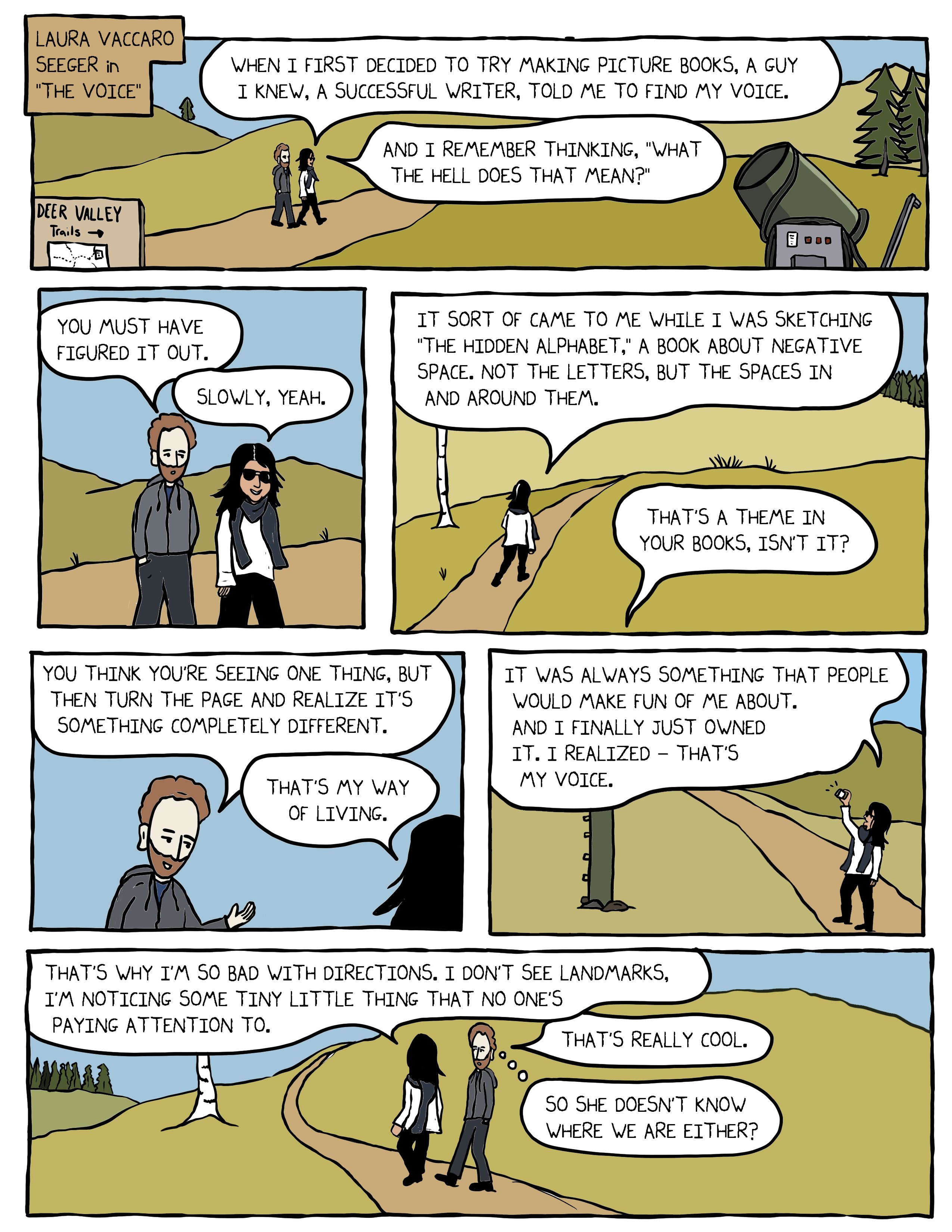
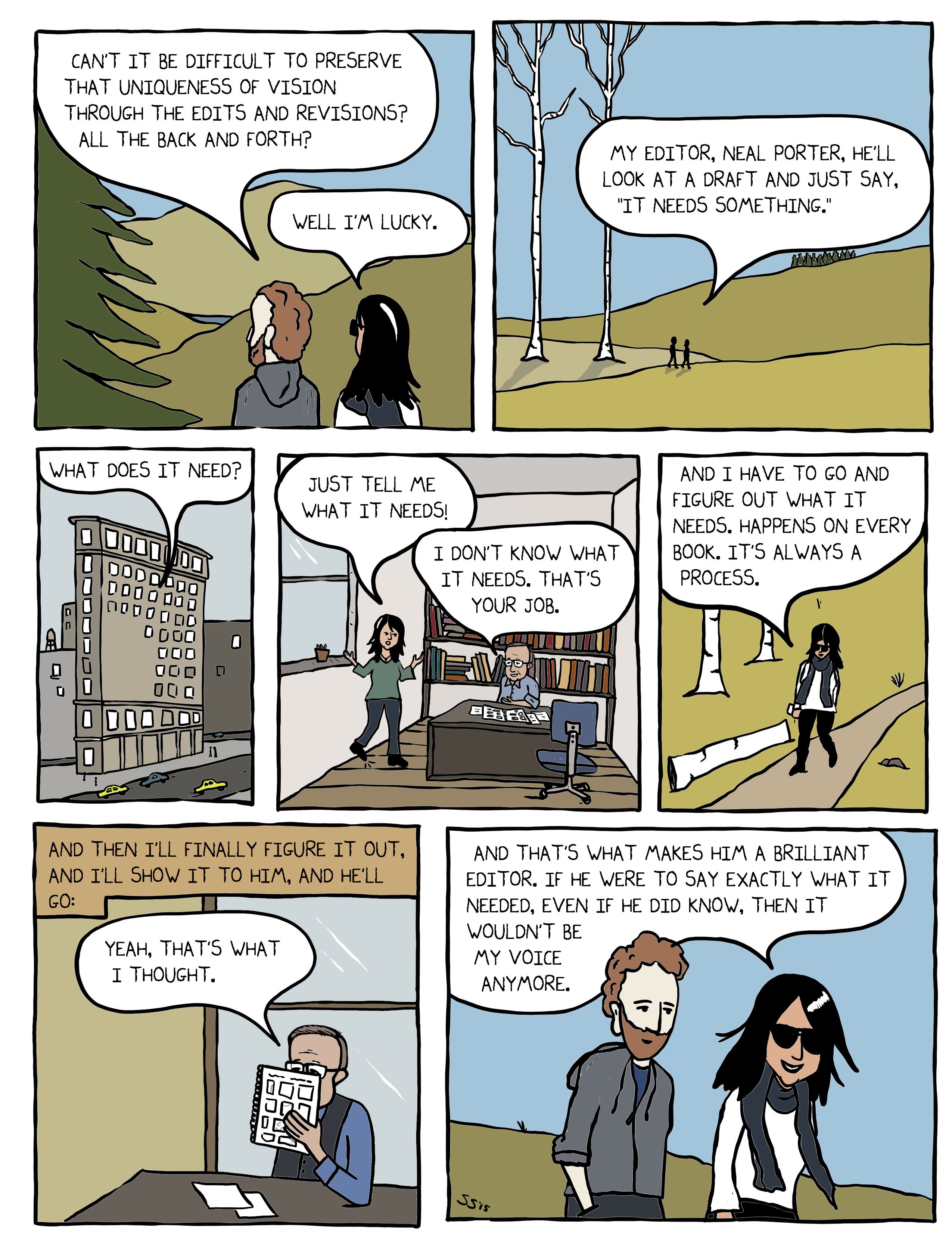
Previous editions of this series include:

By:
Gi Hallmark,
on 2/5/2015
Blog:
The Children's Book Review
(
Login to Add to MyJacketFlap)
JacketFlap tags:
Historical Fiction,
Slavery,
featured,
World War I,
Military,
Jacqueline Woodson,
Roaring Brook Press,
Middle Grade Books,
Random House Books for Young Readers,
Michael Morpurgo,
Equal Rights,
Steve Sheinkin,
Scholastic Press,
Deborah Wiles,
World War 2,
Sharon M. Draper,
Lea Wait,
Freedom Summer,
Ku Klux Klan,
Islandport Press,
Nancy Paulsen Books,
Military Stories,
Feiwel & Friends books,
Sharon Lovejoy,
Ages 9-12,
Book Lists,
Black History Month,
Civil Rights,
Books for Boys,
Atheneum Books for Young Readers,
Award Winners,
Books for Girls,
African American History Month,
Teens: Young Adults,
Cultural Wisdom,
Poetry & Rhyme,
Add a tag
February is African American History Month. Sharing these books with young readers comes with the responsibility to discuss ... progress towards equality.
.jpg?picon=107)
By:
Lizzy Burns,
on 1/7/2015
Blog:
A Chair, A Fireplace and A Tea Cozy
(
Login to Add to MyJacketFlap)
JacketFlap tags:
reviews,
history,
memoir,
nonfiction books,
roaring brook press,
2014,
Steve Sheinkin,
YALSA nonfiction award,
Shane Burcaw,
Add a tag
Two of the finalists for the YALSA Excellence in Nonfiction Award.
The Port Chicago 50: Disaster, Mutiny, and the Fight for Civil Rights by Steve Sheinkin. Roaring Brook Press. 2014. Review copy from publisher.
by Steve Sheinkin. Roaring Brook Press. 2014. Review copy from publisher.
The Port Chicago 50 tells a story that I was not familiar with -- actually, many stories I was not familiar with. The Port Chicago 50 are fifty African American sailors accused of mutiny in the aftermath of the Port Chicago disaster. I don't want to go into the details of the disaster or the mutiny accusations or the aftermath -- read the book!
The story of these fifty men is not just about allegations of mutiny and these fifty individuals; it is also bout the segregation of the Navy and other armed forces before and during World War II and the efforts to end it. It's about just what it meant, to have segregated troops, and institutionalized racism both within and without the armed forces. Segregation and racism, and the actions at Port Chicago and by the sailors, cannot be viewed in isolation of each other.
Laughing at My Nightmare
by
Shane Burcaw.
Roaring Brook Press. 2014. Review copy from publisher.
Burcaw's memoir, based on his tumblr of the same name, is a humorous look at his life with spinal muscular atrophy. It's told in short, episodic chapters -- while it's roughly chronological in order, it doesn't have to be read in order or even all at once. This structure is both a weakness and a strength: those wanting an in depth, detailed examination will be disappointed. But, that's looking for this bok to be something it isn't. It is, instead, a funny, hilarious look at life. And that is it's strength: the short chapters means it's easy to read, and also easy to read over an extended period of time. A few chapters here, a few chapters there, is, a think, the best way to approach
Laughing at My Nightmare.
While Burcaw's memoir is uniquely about his own experiences, it's also universal. Starting middle school, worrying about making friends, anxious about a first kiss -- Burcaw isn't the first person to worry about these things. Burcaw is funny and blunt: he knows teen readers will wonder "but how does he go to the bathroom?" and so he addresses those questions. And the humor is such that will appeal to a lot of teen readers.
Amazon Affiliate. If you click from here to Amazon and buy something, I receive a percentage of the purchase price.
© Elizabeth Burns of
A Chair, A Fireplace & A Tea Cozy
I am a Cybils second round judge. I am currently reading the all the nominated books in a fun "armchair readalong" way with the first round judges. My reviews and opinions are strictly my own and do not reflect the work of the committee.
 The Port Chicago 50: Disaster, Mutiny, and the Fight for Civil Rights Steve Sheinkin
The Port Chicago 50: Disaster, Mutiny, and the Fight for Civil Rights Steve Sheinkin
During WWII, the armed forces were still segregated. Black men who signed up were subjected to segregated mess halls (sometimes eating the cold leftovers of their white counterparts) and barracks, and given the most menial jobs. They were often treated even worse when they were off base.
In the Navy, black sailors were only allowed to be mess attendants when on a ship. They weren’t eligible for promotion. At California’s Port Chicago, they had to load ammunition onto ships. Only black sailors had to do this and they were not given any training on how to properly handle explosives. Their white commanding officers took bets on which Divisions could load the most, creating a hurried and unsafe atmosphere.
On July 17th, 1944, there was an explosion. A small one, then a big one. 320 men died (202 were black men loading ammunition.) Another 390 were injured (mostly due to flying glass when the shock wave blew out windows.) The 1200 foot pier was gone, as were the 2 battle ships being loaded. No one’s entirely sure what happened or why, because anyone who saw it was killed immediately.
On August 9th, the black sailors, some still recovering from their injuries, were told to go back to work loading ammunition. 258 (out of 328) refused, saying they would obey any order but that one. On August 11th, facing mutiny charges, 208 returned to work. The remaining 50 were charged.
The trail was a racist farce and all were found guilty, sentenced to 15 years of hard labor, followed by dishonorable discharge. In 1946 their sentences were commuted and eventually all were discharged with honorable conditions (which is better than dishonorable, but not honorable. You can get VA benefits, but not the GI Bill). In 1999, President Clinton pardoned one of the mutineers, but many did not want a pardon--they wanted their convictions overturned.
Today, all of them have passed on. All of them are still convicted of mutiny.
No one will be surprised to hear that once again Steve Sheinkin has written a riveting account of history. It is a great one for WWII or Black History projects, or anyone interested in injustice, legal dramas, or the armed forces. In true Sheinkin fashion, he pulls in many threads--American racism, the Navy and War Department’s unwillingness to challenge that status quo, the personal stories of many of the sailors involved, the story of what was actually happening, and the impact it had in larger society then and today.
One thing I found interesting--Thurgood Marshall is introduced as an NAACP lawyer, working throughout the war to help defend black armed service personnel from racist persecution and injustice. He watched the trial and foughtfor years to appeal. But, it never mentions what Marshall goes on to eventually do. (I mean, it’s not like we all grow up to be Supreme Court Justices.)
There are many photographs throughout the text (unfortunately, a few have been blown up too largely and are pixelated) and I love the trim size--even though it’s written a bit younger than younger than Bomb: The Race to Build--and Steal--the World's Most Dangerous Weaponor The Notorious Benedict Arnold: A True Story of Adventure, Heroism & Treachery, but the trim size should entice older readers to pick it up.
It’s a story that many have sadly forgotten, but Sheinkin’s powerful storytelling will hopefully tell this story to many more readers.
Book Provided by... my local library
Links to Amazon are an affiliate link. You can help support Biblio File by purchasing any item (not just the one linked to!) through these links. Read my full disclosure statement.
 A few years ago I was researching a book on the making of the atomic bomb, and my brother-in-law Eric, who loves wacky conspiracy theories, as I do, hit me with a great one.
A few years ago I was researching a book on the making of the atomic bomb, and my brother-in-law Eric, who loves wacky conspiracy theories, as I do, hit me with a great one.
“You know when the first atomic bomb was tested, right?” he asked.
“Sure,” I said, falling into his trap. “New Mexico desert, summer of 1945.”
“That’s what they want you to think!”
And he told me the theory: the first test was actually in a place called Port Chicago, California, in July 1944. Sounded crazy, but I’d never heard of Port Chicago. I couldn’t offer any kind of refutation. But later that night I typed “Port Chicago” into Google, and I’ve been hooked on the story ever since — the true story of what happened there during World War II.
Step one for me was reading Dr. Robert Allen’s remarkable book The Port Chicago Mutiny. I then contacted Robert (he said I could call him that) and asked how I could find out more about this little-known chapter of civil rights history. After directing me to the scant supply of written sources, he suggested that if I really wanted to explore this story I should come to the memorial event held each year at the site of the disaster. A few Port Chicago veterans still attend, he explained, though at this point it’s mostly younger generations of family members and friends.
I flew to Oakland in July 2011. Not only did Robert drive me to the memorial event, he spent three days taking me around the Bay Area and introducing me to the amazing community of people who are working to keep the Port Chicago story alive. At the end of my visit, he allowed me to make photocopies of the transcripts of the oral-history interviews he had conducted, decades earlier, with many of the Port Chicago sailors. This priceless material makes up the heart of my book. My deepest thanks to Robert for his generosity, encouragement, and helpful suggestions along the way.
And as an additional tribute, I want to use the rest of this speech to tell the story of Robert’s own Port Chicago journey — a classic old-school detective tale.
“This was the mid-1970s,” Robert remembers. “I was a grad student at Berkeley, and also working as a journalist, working on a story about some racial incidents that had happened on ships in the U.S. Navy. In an archive, I came across this pamphlet entitled ‘Mutiny?’ It had a picture of some black sailors on the front. I picked it up and thought, ‘What’s this about?’ The first sentence in there was, ‘Remember Port Chicago?’
“I thought, ‘Port Chicago?’ Do they mean the port of Chicago? What is this?’ And I read it, and it told the story of a terrible disaster at Port Chicago, which is in California, near San Francisco, a small port town, where they had built a Navy base, an ammunition loading facility. And it turned out that all the ammunition loaders were black, all the officers, white.”
The pamphlet, printed by the NAACP in 1945, told the Port Chicago story: the strict segregation in the Navy, the lack of training and unsafe working conditions for black sailors at Port Chicago, the disastrous explosion that killed more than three hundred, and the “mutiny” — the refusal of fifty of the men to return to work under unfair and unsafe conditions.
“I was just amazed as I read this,” Robert says. He asked the archivist if he could make a photocopy, and was told he could just take one of the pamphlets; they had several. “So I took a copy, which I still have, and came home, read through it again, and went to the library right away. I wanted to check out a book about it. But there was nothing. I looked in the standard black history references, and it’s briefly mentioned in John Hope Franklin, one sentence, that’s it. But all of this had intrigued me, because clearly this was a huge story and nothing had been written about it. So I’m thinking, ‘I’m going to have to find some way to find out about this story,’ because by now I was really hooked. The explosion and this so-called mutiny, and then the whole thing just disappears from history.”
Robert read through the newspaper archives at UC Berkeley and found many stories about the Port Chicago explosion, and a few about the subsequent mutiny trial. “But just as quickly, the story disappeared. It’s the middle of a war, 1944, so there’s some dramatic news happening every day.”
Other work pushed Port Chicago aside for a while — but the story wouldn’t let Robert go. “This is really just a fantastic story,” he thought again and again. “How can I begin to learn more about it? What I need is something to start with.” He had the newspaper accounts, but they were brief and often contradictory. “Then I thought, ‘There’s a trial. There’s a mutiny trial, and there must be a mutiny trial transcript. If I could get hold of that, I might have access to the whole story.’”
So he contacted the Navy the old-fashioned way — he looked up the number and called them. He was lucky; the records had been declassified in 1972. No one had ever asked to see them.
“Yes, we have them here,” a young clerk told him.
“Do I have to come there to see them, or can I get a copy sent?”
“We can make you a copy if you know exactly what you want.”
“I want exactly the full transcript.”
The man was momentarily speechless. “It’s 1,400 pages!”
“Well,” Robert said, “I want it all.”
He agreed to pay ten cents a page for copies, no small sum for a broke student. “And that,” he says, “was the first big break.”
He got the transcript and started reading, taking notes. But the more he read, the more questions he had. “Because I now had the details of the events that happened, that the men had refused to go back to work. But nothing about what was going on at Port Chicago before that. The trial record was silent on that. And I realized this court had decided that any testimony about events prior to the date of the work-stoppage was irrelevant. The only question was, ‘Did you, or did you not, on August 9th, refuse to return to work loading ammunition?’ The court basically ruled out any testimony about the conditions existing at the base before the explosion. The discrimination, the lack of training, the fact that white officers were betting each other about which division could load the fastest — all of this, which contributed to the men’s anger and outrage, they weren’t allowed to tell any of it in court.”
As Robert read, he tried to see the story from the point of view of the accused mutineers, many of whom were teenagers. “What was it that motivated the men?” he wondered. “It’s never brought out in the trial. This is only half the story. Where’s the other half?”
The answer was that it didn’t exist. Not in any written record, anyway. “And I realized,” he says, “the only way to get it was to find some of the survivors and interview them, especially the fifty, the ones who were involved in the mutiny. And that struck me as a daunting task.” He looked for the names of the defendants in Bay Area phone books and made a few calls. No luck.
“How am I going to find these guys? Well, who would have information about them? The Navy’s personnel department.” So he wrote to the Navy asking for addresses.
The reply: “We cannot release these addresses to you. These records are confidential.”
Robert’s hopes sank. Without the slightest clue as to where the men lived, how he could he begin to find them? But at the bottom of the letter was something surprising. Whoever wrote it had clearly broken from form letter–speak to make a suggestion: Robert could write letters to the men and send them to the Navy, along with self-addressed stamped envelopes. The Navy would forward the letters, and if the men felt like responding to Robert, they would.
This was the turning point. “I got these packets together and sent them out,” he remembers.
There was a long silence after that, and Robert began to doubt he would get any responses. “I’ll never know if the Navy mailed the letters or not,” he thought. “They could have all been thrown in the trash.”
But finally, a response came. Then a few more. Robert was thrilled. He talked to several of the men on the phone, including Joe Small, the man the Navy accused of being the ringleader of the Port Chicago mutiny. It wasn’t easy. “Because for these men, who was I? What was my motive? That’s on everybody’s mind, whether they say it or not, so you have to speak to that.”
He explained what he was trying to do. “Your perspective is missing from the written record,” he told the men. “The story of you and the other sailors, and what was happening in the years, weeks, days before the explosion, that’s not in the written history of Port Chicago. And I want to get your story out.”
Many of the men agreed to talk, and Robert was determined to do it in person. “I learned as a journalist, face-to-face contact is always better,” he says. “You get much more from somebody if you talk to them face to face.”
But that raised a new problem. “I looked at the list of addresses, and every single one of them was along the East Coast and on down into the South. I thought, ‘How in the world am I going to do this?’ I was in graduate school, and graduate students, by definition, are poor. So I really didn’t have the money to make a big trip, but then, reading the newspaper, I saw a Greyhound Bus ad, and they had what they called a ‘See America’ fare. You paid $100 and you could ride any Greyhound Bus anywhere they went in the United States for a month. And I realized, that was my ticket.”
Robert flew the red-eye to New York City. He had a list of men to interview. The first lived in Harlem.
It was nearly the last.
“The very first interview practically stopped me in my tracks,” he says. “I went to the man’s building in Harlem, and he opens the door and says, ‘We can do the interview, but let’s go down the street to my friend’s house.’”
Sure, Robert said, thinking, “This is his interview, and if I want to get it, I have to do it on his terms.” They walked to a neighbor’s apartment and went in. There was no one home. They sat and talked for over an hour. Robert could sense the man relaxing as the interview went on. “But what had happened at his front door was still hanging over me,” he says. When they were done, Robert decided to ask about it.
“I hope I didn’t create a problem for you,” Robert said.
“No, you didn’t create a problem,” the man said, “but my son was home today, my grown son. And if you had come in, I would have had to introduce you, and I didn’t want to do that. Because I’ve never told him what happened to me at Port Chicago. And I’m still not sure I want him to know.”
Robert was stunned. “I hadn’t really thought about how the families might be affected by what had happened, and how that might create pain all these years later.”
He walked to a YMCA and got a room. It was a rough night. “If he hasn’t told his son, what does that mean about how he feels about it?” Robert wondered. “If the men haven’t told their families, what right do I have to be asking these questions? Am I not re-traumatizing them by even asking the questions? I should just get on the bus and go home. Even if the men agree to be interviewed by me, can I really do it? Do I have a right to do it?”
One sleepless night later, he still hadn’t made up his mind. His conscience was telling him to get on a plane and fly home. But he had already bought the bus ticket. And the next person was nearby, in northern Jersey.
“I should do the next interview,” he decided. “I should at least do one more.”
And the next interview was Joe Small. “Thank goodness!” Robert says, laughing. “If it had been a couple of others who came later, I would have said, ‘No, I shouldn’t be doing this.’ Joe Small was ready to talk. His attitude was, ‘I want to get the story out.’”
And the rest is history. History that literally would not exist — not in any form accessible to us today — without Robert Allen’s amazing detective work. All fifty of the men convicted of mutiny at Port Chicago are gone. But their voices live in Robert’s interviews. Their story is very much alive.
For more on the 2014 Boston Globe-Horn Book Awards, click on the tag BGHB14. Read Steve Sheinkin’s .

The post The Port Chicago 50: Author Steve Sheinkin’s 2014 BGHB NF Award Speech appeared first on The Horn Book.
Author and artist Steve Sheinkin continues his marvelous “Walking and Talking” series with us today. The subject? Gene Luen Yang, who draws connections between immigration and superheroes in ways I’ve never really ever considered before. Enjoy!
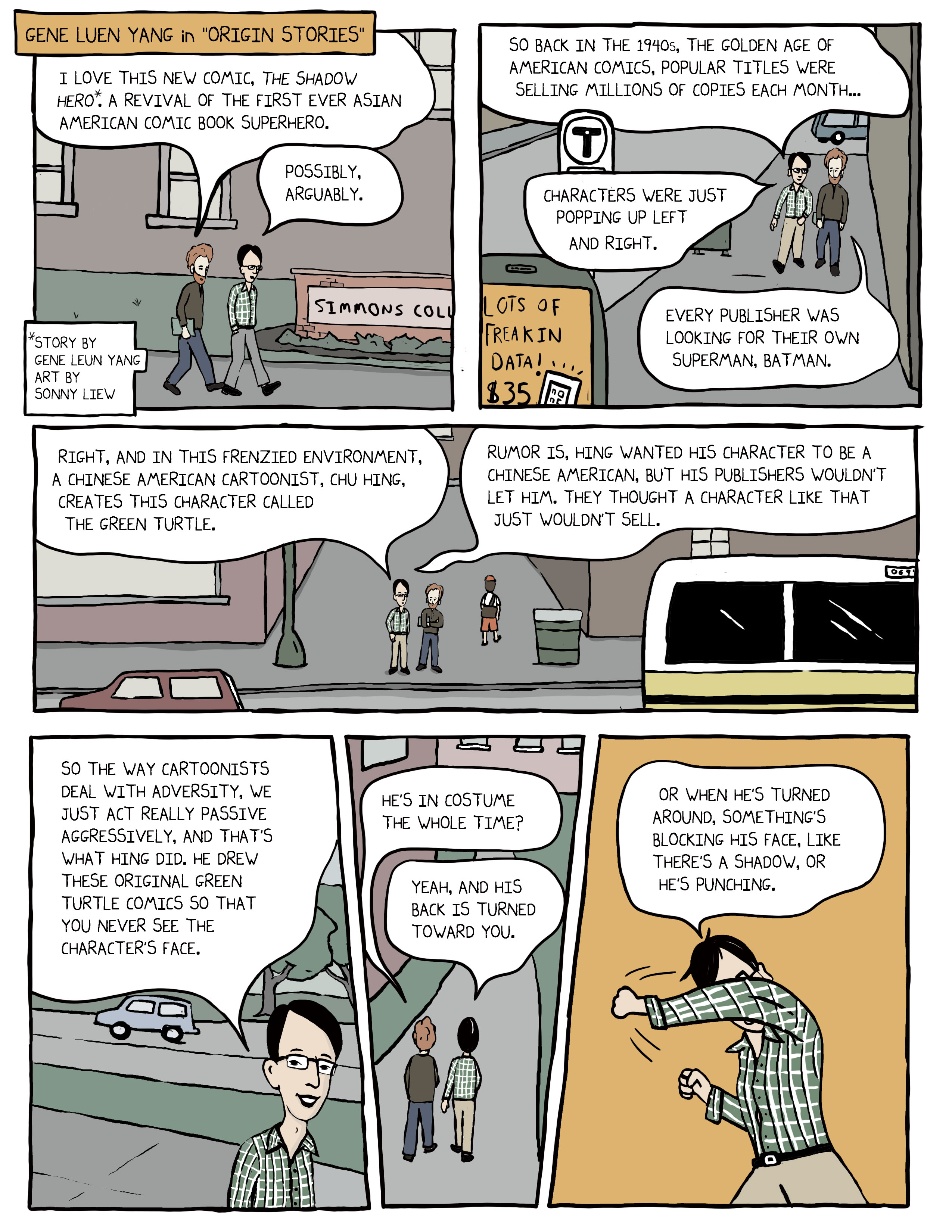
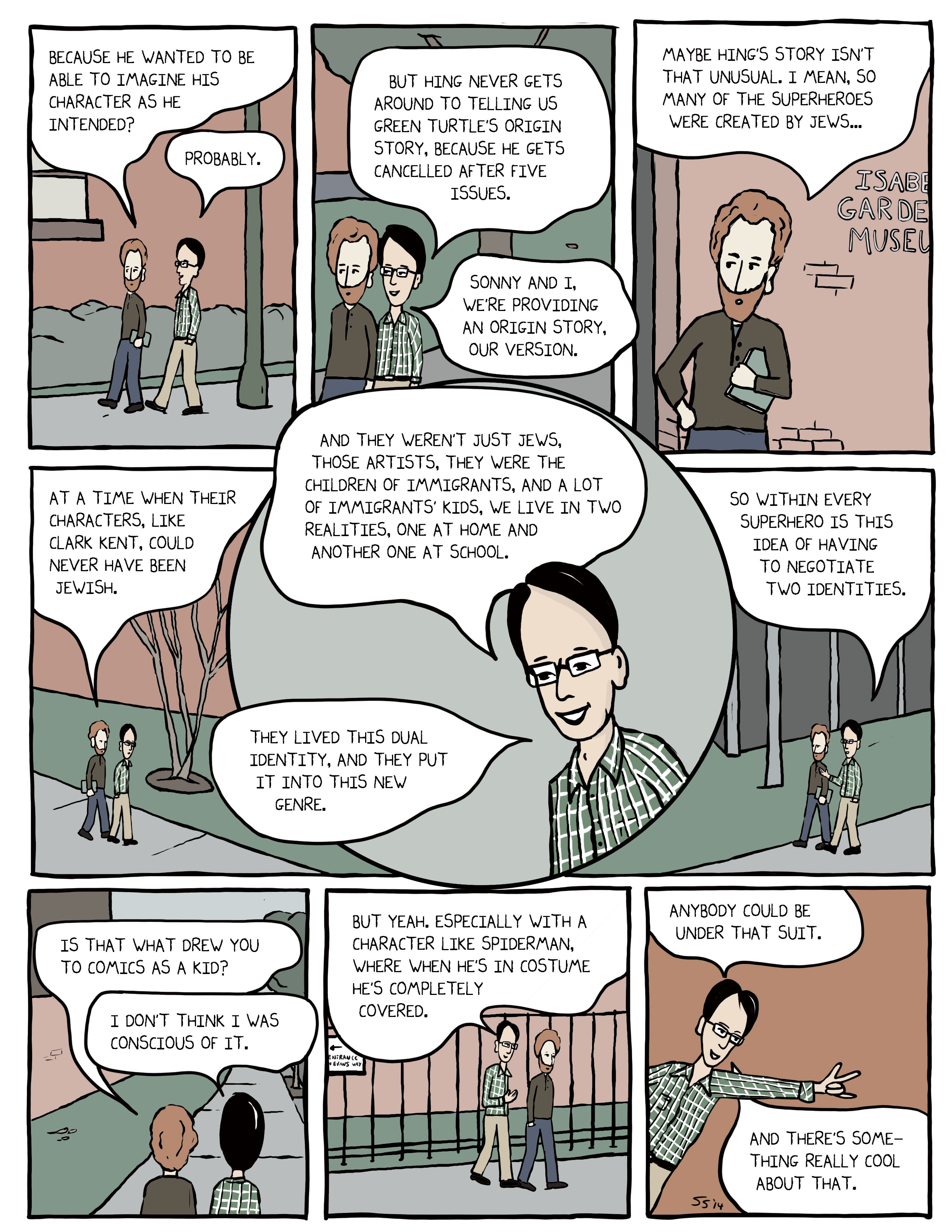
Previous editions of this series include:

 GalleyCat is at the 65th annual National Book Awards tonight in New York. We have been speaking with the nominees about their advice for writers.
GalleyCat is at the 65th annual National Book Awards tonight in New York. We have been speaking with the nominees about their advice for writers.
Maureen N. McLean, the nominee in the poetry category for This Blue said: “Have open ears and read dead writers because they are channeling sounds that are still alive and they might attune you to things in the air that aren’t necessarily on the web or on TV or on a video game. English is a huge big weird language and why not swim in it.”
Steve Sheinkin, Young People’s Literature nominee, for his book The Port Chicago 50: Disaster, Mutiny, and the Fight for Civil Rights told us that the goal is: “to get to that point where you just show it to somebody. Everyone will always tell you, ‘you have to write every day,’ so you know that. But what really accelerates the improvement, is getting past that fear of showing it to somebody and really listening to what they say open-mindedly. It will be so much better after two or three smart and trusted readers have given you feedback and the whole rest of the world will never know that it was bad to begin with.” (more…)
New Career Opportunities Daily: The best jobs in media.
This is our second “Walking and Talking” installment by the clearly multi-talented Steve Sheinkin. This week? Jenni Holm discusses how she works and gives some background on the blood, sweat and tears that went into The Fourteenth Goldfish.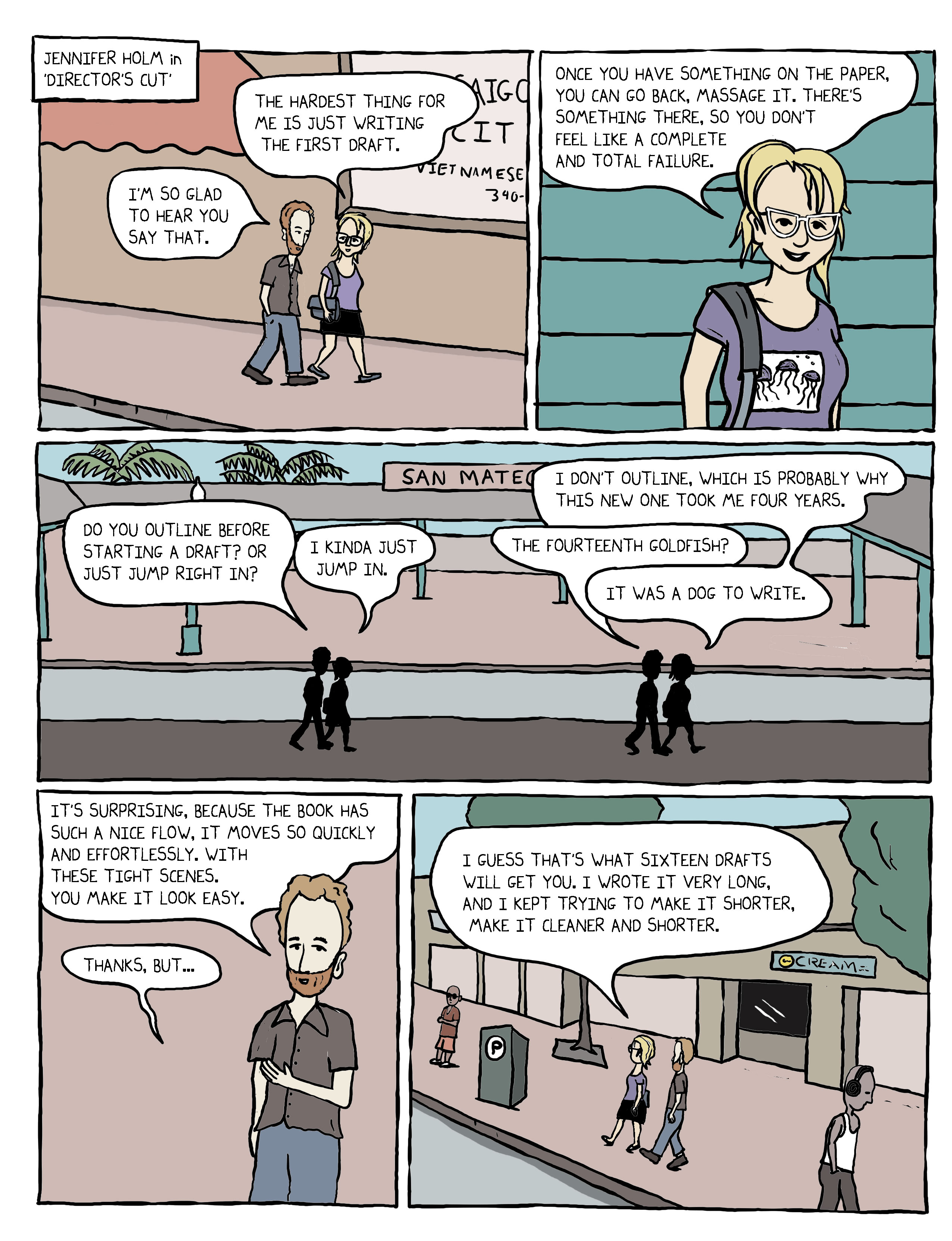
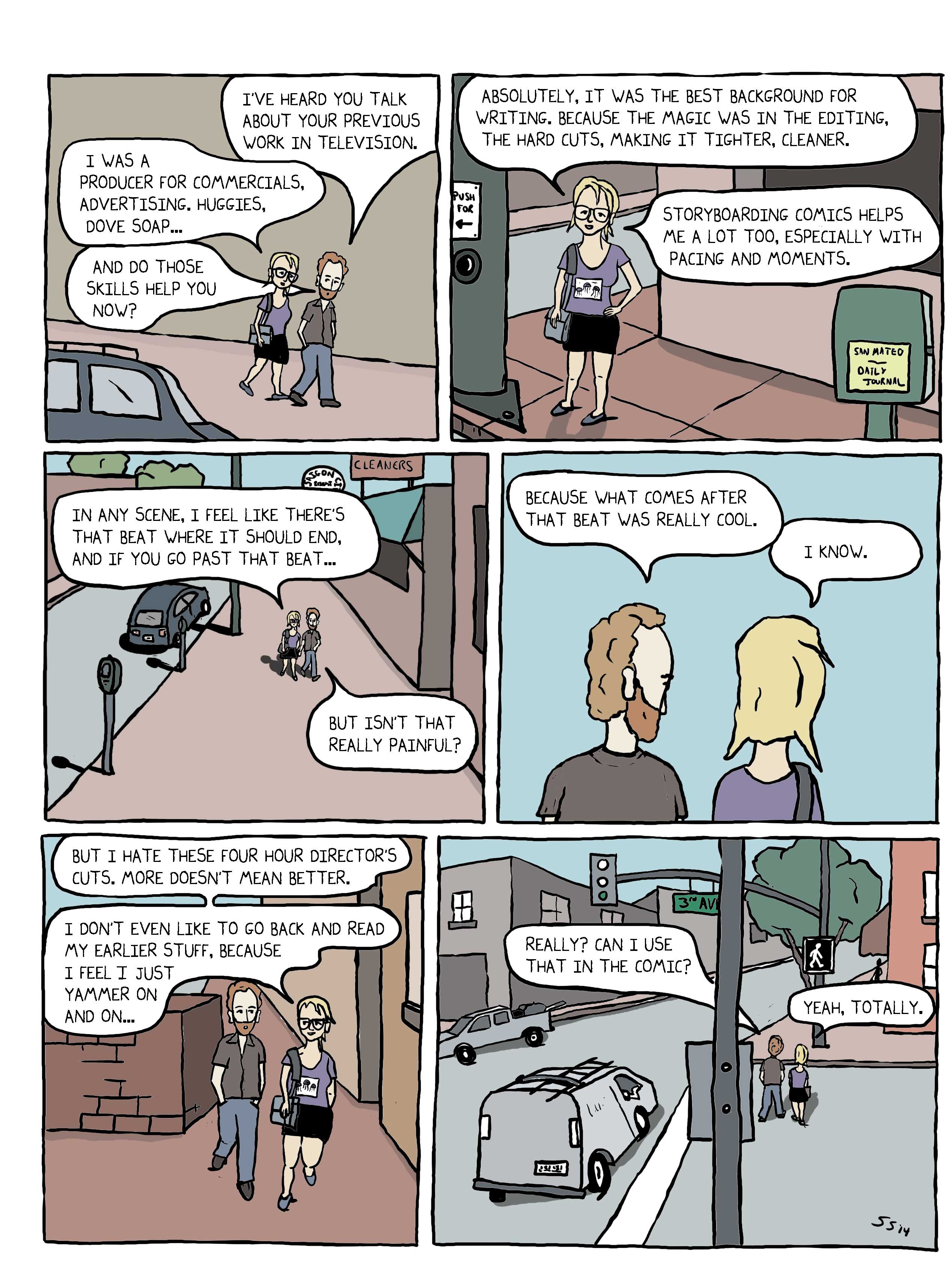
Be also sure to check out the first Walking and Talking with . . . John Corey Whaley. Big thanks to Steven too for letting me post these!

Introducing the all new “Walking and Talking” series by Steve Sheinkin!
I’m always on the lookout for folks I consider double threats. In the children’s and YA book biz that translates to mean people who can both write and draw. Take someone like Kadir Nelson, for example. One day he’s doing his spectacular art, merry as you please, and the next he turns around and shows that he can write books like We Are the Ship. Is that fair? It is not! And now we have a similar situation in the case of National Book Award finalist / Newbery Honoree / even-more-honors author Steve Sheinkin. One moment he’s writing Bomb: The Race to Build – and Steal – the World’s Most Dangerous Weapon, and the next he’s drawing comics.
Comics? Comics! Why? Well, in his own words:
“I love to draw comics, and I meet lots of great writers at various events I go to, so I figured—why not combine the two? The idea is to interview children’s and YA authors and turn the interviews into short comics. Thanks to John Corey Whaley for bravely agreeing to star in this first one.”
Is it any wonder I leapt at the chance to host these? Here then is the first starring Printz winner John Corey Whaley (of Where Things Come Back and Noggin). It marks an entirely different way of interviewing some of the luminaries in the field.
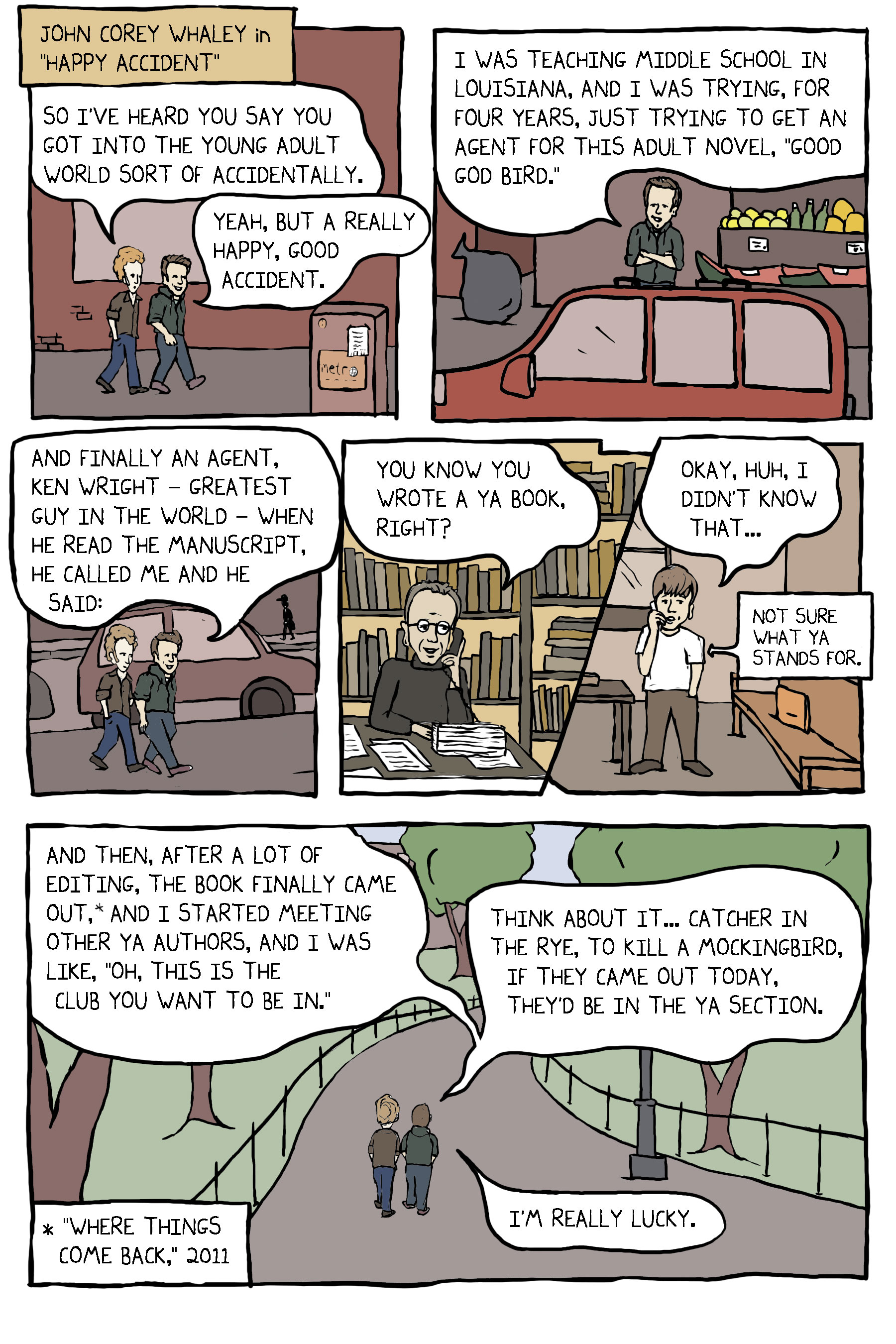
 For more info on Steve and his myriad works, head on over to www.stevesheinkin.com. And stayed tuned for more of these comics. This is only the beginning.
For more info on Steve and his myriad works, head on over to www.stevesheinkin.com. And stayed tuned for more of these comics. This is only the beginning.


By: Jason Boog,
on 10/10/2012
Blog:
Galley Cat (Mediabistro)
(
Login to Add to MyJacketFlap)
JacketFlap tags:
Awards,
Louise Erdrich,
Junot Diaz,
Patricia McCormick,
Dave Eggers,
Ben Fountain,
Steve Sheinkin,
Eliot Schrefer,
Susan Wheeler,
Domingo Martinez,
Kevin Powers,
Anthony Shadid,
Katherine Boo,
Tim Seibles,
William Alexander,
Robert A. Caro,
Alan Shapiro,
Anne Applebaum,
Carrie Arcos,
Cynthia Huntington,
David Ferry,
Junot Díaz,
Add a tag
 Junot Diaz, Dave Eggers, and Louise Erdrich led the list of fiction finalists for the National Book Awards this year.
Junot Diaz, Dave Eggers, and Louise Erdrich led the list of fiction finalists for the National Book Awards this year.
Follow the links below to read free samples of the finalists in every category–who is your favorite?
The finalists were announced on MSNBC this year, a new twist for the prestigious award. The winners will be revealed at a gala ceremony on November 14 in New York City at Cipriani Wall Street.
continued…
New Career Opportunities Daily: The best jobs in media.
View Next 6 Posts















 The Port Chicago 50:
The Port Chicago 50: Steve Sheinkin’s young adult history books — including Bomb: The Race to Build — and Steal — the World’s Most Dangerous Weapon (a Newbery Honor Book, a National Book Award finalist, and the winner of both the Sibert Award and the YALSA Award for Excellence in Nonfiction for Young Adults) and The Port Chicago 50: Disaster, Mutiny, and the Fight for Civil Rights (a
Steve Sheinkin’s young adult history books — including Bomb: The Race to Build — and Steal — the World’s Most Dangerous Weapon (a Newbery Honor Book, a National Book Award finalist, and the winner of both the Sibert Award and the YALSA Award for Excellence in Nonfiction for Young Adults) and The Port Chicago 50: Disaster, Mutiny, and the Fight for Civil Rights (a 



 Strike of 1909
Strike of 1909








 GalleyCat is at the 65th annual National Book Awards tonight in New York. We have been speaking with the nominees about their advice for writers.
GalleyCat is at the 65th annual National Book Awards tonight in New York. We have been speaking with the nominees about their advice for writers.



 Junot Diaz, Dave Eggers, and Louise Erdrich led the list of fiction finalists for the National Book Awards this year.
Junot Diaz, Dave Eggers, and Louise Erdrich led the list of fiction finalists for the National Book Awards this year.
My two favorite authors, walking and talking… and with such author-ly insight!
I swoon for the second time in as many days reading your blog, Besty.
“The thing is to not panic.” Going up over my desk.